tow Seat Alhambra 2006 User Guide
[x] Cancel search | Manufacturer: SEAT, Model Year: 2006, Model line: Alhambra, Model: Seat Alhambra 2006Pages: 299, PDF Size: 6.33 MB
Page 116 of 299

Lights and visibility 114
Note
•If not all the vehicle doors are closed, the interior lights will be switched
off after approx. 10 minutes, providing the key has been removed and the
courtesy light position selected. This prevents the battery discharging.
•Reading lights function independently of the interior lights and must be
switched off manually to prevent the battery being drained when the engine
is switched off.
Interior light
Interior light permanently switched off
– In switch position �Ÿfig. 77, the interior and reading lights
are switched off.Switching on the reading light
– Turn the switch to position (left reading light) or to position
(right reading light).
Door light position
– Turn the control to position . The interior lights are automati-
cally switched on when the vehicle is unlocked or the key
removed from the ignition lock The light turns off about 20
seconds after the closure of the doors. The interior lights are
switched off when the vehicle is locked or when the ignition is
switched on.
Interior lights or both reading lights switched on
– Turn the control to position .
Visibility
Sun visors
The sun visors for the driver and front passenger can be folded down or pulled
out of their mountings and turned towards the doors.
The make-up mirrors in the sun visors have covers. When you open the cover
, a lamp* in the roof lights up.
The roof light goes off when the cover of the make-up mirror is closed.
Note
Before you leave the car, you should make sure that the make-up mirror cover
in the visor is closed. This prevents the battery discharging.
Fig. 77 Interior light
A1
A2
A4
A3
A5
A2
Page 119 of 299
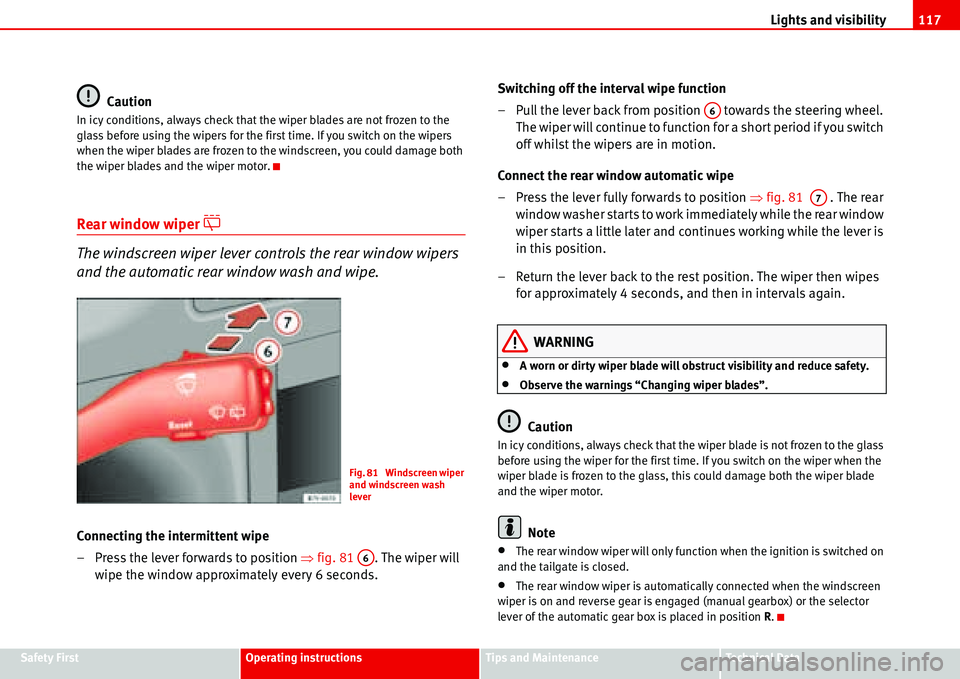
Lights and visibility117
Safety FirstOperating instructionsTips and MaintenanceTe c h n i c a l D a t a
Caution
In icy conditions, always check that the wiper blades are not frozen to the
glass before using the wipers for the first time. If you switch on the wipers
when the wiper blades are frozen to the windscreen, you could damage both
the wiper blades and the wiper motor.
Rear window wiper �]
The windscreen wiper lever controls the rear window wipers
and the automatic rear window wash and wipe.
Connecting the intermittent wipe
– Press the lever forwards to position �Ÿfig. 81 . The wiper will
wipe the window approximately every 6 seconds.Switching off the interval wipe function
– Pull the lever back from position towards the steering wheel.
The wiper will continue to function for a short period if you switch
off whilst the wipers are in motion.
Connect the rear window automatic wipe
– Press the lever fully forwards to position �Ÿfig. 81 . The rear
window washer starts to work immediately while the rear window
wiper starts a little later and continues working while the lever is
in this position.
– Return the lever back to the rest position. The wiper then wipes
for approximately 4 seconds, and then in intervals again.
WARNING
•A worn or dirty wiper blade will obstruct visibility and reduce safety.
•Observe the warnings “Changing wiper blades”.
Caution
In icy conditions, always check that the wiper blade is not frozen to the glass
before using the wiper for the first time. If you switch on the wiper when the
wiper blade is frozen to the glass, this could damage both the wiper blade
and the wiper motor.
Note
•The rear window wiper will only function when the ignition is switched on
and the tailgate is closed.
•The rear window wiper is automatically connected when the windscreen
wiper is on and reverse gear is engaged (manual gearbox) or the selector
lever of the automatic gear box is placed in position R.
Fig. 81 Windscreen wiper
and windscreen wash
lever
A6
A6
A7
Page 120 of 299
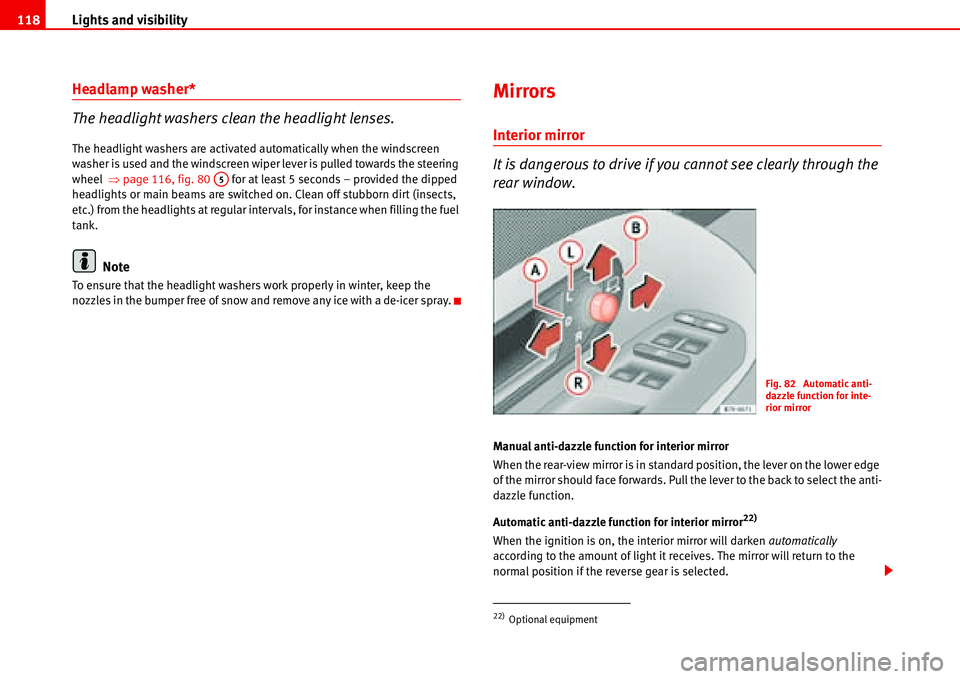
Lights and visibility 118
Headlamp washer*
The headlight washers clean the headlight lenses.
The headlight washers are activated automatically when the windscreen
washer is used and the windscreen wiper lever is pulled towards the steering
wheel �Ÿpage 116, fig. 80 for at least 5 seconds – provided the dipped
headlights or main beams are switched on. Clean off stubborn dirt (insects,
etc.) from the headlights at regular intervals, for instance when filling the fuel
tank.
Note
To ensure that the headlight washers work properly in winter, keep the
nozzles in the bumper free of snow and remove any ice with a de-icer spray.
Mirrors
Interior mirror
It is dangerous to drive if you cannot see clearly through the
rear window.
Manual anti-dazzle function for interior mirror
When the rear-view mirror is in standard position, the lever on the lower edge
of the mirror should face forwards. Pull the lever to the back to select the anti-
dazzle function.
Automatic anti-dazzle function for interior mirror
22)
When the ignition is on, the interior mirror will darken automatically
according to the amount of light it receives. The mirror will return to the
normal position if the reverse gear is selected.
A5
22)Optional equipment
Fig. 82 Automatic anti-
dazzle function for inte-
rior mirror
Page 123 of 299

Seats and stowage121
Safety FirstOperating instructionsTips and MaintenanceTe c h n i c a l D a t a
Seats and stowage
The importance of correct seat adjustment
Proper seat adjustment optimises the level of protection
offered by seat belts and airbags.
The driver seat, front passenger seat, and seats in the passenger compart-
ment, can be adjusted in many ways to suit the physical requirements of the
vehicle occupants. The correct seat position is very important for:
•fast and easy operation of all controls on the instrument panel,
•relaxed posture that does not cause drowsiness,
•safe driving,
•optimum protection from the seat belts and airbag system �Ÿpage 7.
Vehicle seats
Your vehicle has a total of five or seven
24) seats.
•First row of seats: two seats
•Second row of seats: three seats
•Third row of seats24): two seats
Each seat is equipped with a three-point seat belt.
WARNING
If the driver and passengers assume improper sitting positions, they may
sustain critical injuries.
•Never transport more people than there are seats available in the
vehicle.
•Every occupant in the vehicle must properly fasten and wear the seat
belt belonging to his or her seat. Children must be protected with an appro-
priate child restraint system. Section “Child Safety”
•The seats and all head restraints must always be adjusted to body size
and the seat belt must always be properly adjusted to provide you and your
passengers with optimum protection.
•Always keep your feet in the foot well when the vehicle is moving; never
rest them on the dash panel, out of the window or on the seat. This also
applies to passengers. An incorrect sitting position exposes you to an
increased risk of injury in the event of a braking manoeuvre or an accident.
If the airbag is triggered, you could sustain fatal injuries due to an improper
sitting position.
•It is important for the driver and front passenger to maintain a distance
of at least 25 cm from the steering wheel or dash panel. Failure to respect
the minimum distance means that the airbag will not protect you. Risk of
fatal injury. The distance between the driver and the steering wheel or
between the front passenger and the dash panel should always be as great
as possible.
•Adjust the driver or front passenger seat only when the vehicle is
stationary. Otherwise your seat could move unexpectedly while the vehicle
is moving. This could increase the risk of an accident and therefore injury.
In addition, while adjusting your seat, you will assume an incorrect sitting
position. Risk of fatal accidents.
•Special guidelines apply to installing a child seat on the front
passenger seat. When installing a child seat, observe the warning note in
“Child safety”.
•The seats in the third row of seats may, for safety reasons, only be used
if the luggage compartment cover has been removed.
24)Optional equipment
WARNING (continued)
Page 124 of 299

Seats and stowage 122
Head restraints
Correct adjustment of head restraints
Properly adjusted head restraints are an important part of
occupant protection and can reduce the risk of injuries in
most accident situations.
– Adjust the head restraint so that its upper edge is at the same
level as the top of your head �Ÿfig. 84 and �Ÿfig. 85.
Adjusting the head restraints �Ÿpage 123
WARNING
Travelling with the head restraints removed or improperly adjusted
increases the risk of severe injuries.
•Improperly adjusted head restraints could lead to death in the event of
a collision or accident.
•Incorrectly adjusted head restraints also increase the risk of injury
during sudden or unexpected driving or braking manoeuvres.
•The head restraints must always be adjusted according to the occu-
pant's size.
Fig. 84 Viewed from in
front: Properly adjusted
head restraints and
proper belt adjustment
Fig. 85 Viewed from side:
Properly adjusted head
restraints and proper belt
adjustment
Page 125 of 299
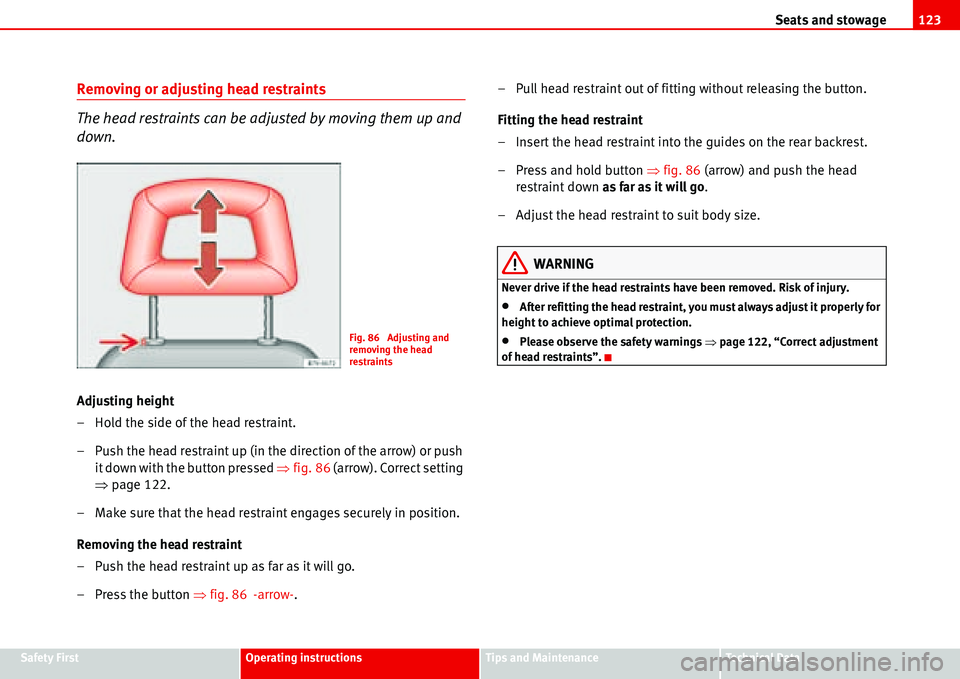
Seats and stowage123
Safety FirstOperating instructionsTips and MaintenanceTe c h n i c a l D a t a
Removing or adjusting head restraints
The head restraints can be adjusted by moving them up and
down.
Adjusting height
– Hold the side of the head restraint.
– Push the head restraint up (in the direction of the arrow) or push
it down with the button pressed �Ÿfig. 86 (arrow). Correct setting
�Ÿpage 122.
– Make sure that the head restraint engages securely in position.
Removing the head restraint
– Push the head restraint up as far as it will go.
– Press the button �Ÿfig. 86 -arrow-.– Pull head restraint out of fitting without releasing the button.
Fitting the head restraint
– Insert the head restraint into the guides on the rear backrest.
– Press and hold button �Ÿfig. 86 (arrow) and push the head
restraint down as far as it will go.
– Adjust the head restraint to suit body size.
WARNING
Never drive if the head restraints have been removed. Risk of injury.
•After refitting the head restraint, you must always adjust it properly for
height to achieve optimal protection.
•Please observe the safety warnings �Ÿpage 122, “Correct adjustment
of head restraints”.Fig. 86 Adjusting and
removing the head
restraints
Page 126 of 299

Seats and stowage 124
Front seats
Adjusting front seats
The control elements �Ÿfig. 87 are mirrored for the front right-hand
seat.
Adjusting the seat forwards and backwards
– Pull up the lever and move the seat forwards or backwards
�Ÿ.
– Then release the grip and move the seat further until the
catch engages.
Adjusting the backrest angle
– Take your weight off the backrest and turn the hand wheel.Adjusting the lumbar support
25)
– Take your weight off the backrest and turn the hand wheel.
Turning the seat
25)
– Adjust the seat surface to its lowest position and push the seat
back as far as it will go.
–On the driver's seat, adjust the backrest fully forward so that it
will not hit the steering wheel when turning the seat round.
– Lift the lever and turn the seat round �Ÿ.
Adjusting the seat height
– Pull the lever up or push down (several times if necessary) from
its home position. This adjusts the seat height in stages �Ÿ
Adjusting the armrest
25)
– Turn the thumb wheel underneath the arm rest to adjust it to the
size of the occupant.
The curvature of the cushioned area is determined by the settings made in
the lumbar region. This supports the natural curvature of the spine very effec-
tively.
WARNING
•Never adjust the driver or front passenger seat while the vehicle is in
motion. While adjusting your seat, you will assume an incorrect sitting
position. Risk of injury. Adjust the driver or front passenger seat only when
the vehicle is stationary.
Fig. 87 Front left seat
controls
A1
A1
A2
25)Optional equipment
A3
A4
A4
A5
A6
Page 127 of 299
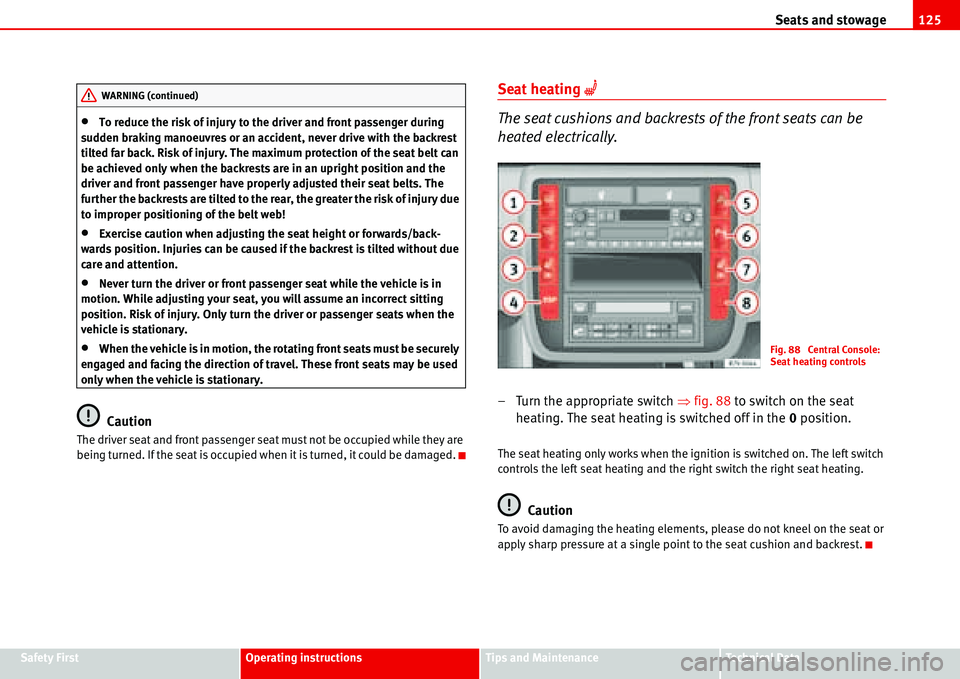
Seats and stowage125
Safety FirstOperating instructionsTips and MaintenanceTe c h n i c a l D a t a
•To reduce the risk of injury to the driver and front passenger during
sudden braking manoeuvres or an accident, never drive with the backrest
tilted far back. Risk of injury. The maximum protection of the seat belt can
be achieved only when the backrests are in an upright position and the
driver and front passenger have properly adjusted their seat belts. The
further the backrests are tilted to the rear, the greater the risk of injury due
to improper positioning of the belt web!
•Exercise caution when adjusting the seat height or forwards/back-
wards position. Injuries can be caused if the backrest is tilted without due
care and attention.
•Never turn the driver or front passenger seat while the vehicle is in
motion. While adjusting your seat, you will assume an incorrect sitting
position. Risk of injury. Only turn the driver or passenger seats when the
vehicle is stationary.
•When the vehicle is in motion, the rotating front seats must be securely
engaged and facing the direction of travel. These front seats may be used
only when the vehicle is stationary.
Caution
The driver seat and front passenger seat must not be occupied while they are
being turned. If the seat is occupied when it is turned, it could be damaged.
Seat heating �A
The seat cushions and backrests of the front seats can be
heated electrically.
– Turn the appropriate switch �Ÿfig. 88 to switch on the seat
heating. The seat heating is switched off in the 0 position.
The seat heating only works when the ignition is switched on. The left switch
controls the left seat heating and the right switch the right seat heating.
Caution
To avoid damaging the heating elements, please do not kneel on the seat or
apply sharp pressure at a single point to the seat cushion and backrest.
WARNING (continued)
Fig. 88 Central Console:
Seat heating controls
Page 128 of 299
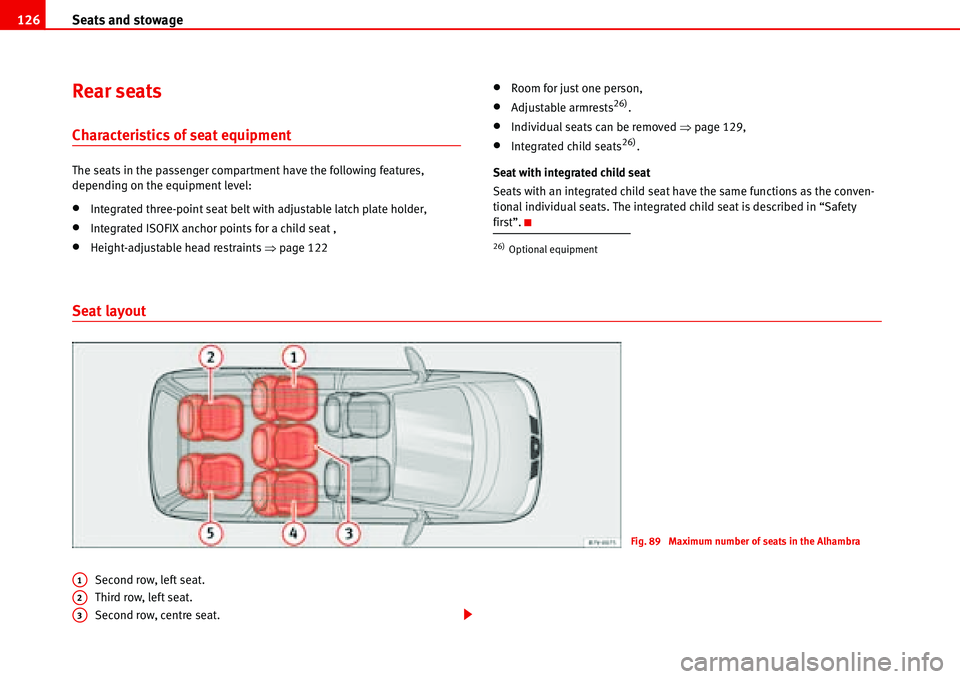
Seats and stowage 126
Rear seats
Characteristics of seat equipment
The seats in the passenger compartment have the following features,
depending on the equipment level:
•Integrated three-point seat belt with adjustable latch plate holder,
•Integrated ISOFIX anchor points for a child seat ,
•Height-adjustable head restraints �Ÿpage 122
•Room for just one person,
•Adjustable armrests26).
•Individual seats can be removed �Ÿpage 129,
•Integrated child seats26).
Seat with integrated child seat
Seats with an integrated child seat have the same functions as the conven-
tional individual seats. The integrated child seat is described in “Safety
first”.
Seat layout
Second row, left seat.
Third row, left seat.
Second row, centre seat.
26)Optional equipment
Fig. 89 Maximum number of seats in the Alhambra
A1
A2
A3
Page 129 of 299

Seats and stowage127
Safety FirstOperating instructionsTips and MaintenanceTe c h n i c a l D a t a Second row, right seat
27).
Third row, right seat27).
Notes on the installation of the seats
•Seats and are of the same construction and thus interchangeable.
•Seats and are of the same construction and thus interchangeable.
•Seat can be installed in positions .
•The seat can be installed in positions , , and .
Moving seats
– Make sure that the vehicle is not on a steep slope.
– Pull the unlock lever �Ÿfig. 90 upwards, in the direction of the
arrow, and hold in this position.–Move the seat.
– Return the lever back to the rest position.
– Always ensure that the seat is securely engaged.
WARNING
•Please be careful when adjusting the seat backwards and forwards!
Injuries can be caused if the backrest is tilted without due care and atten-
tion.
•Adjust the seat only when the vehicle is stationary. Otherwise your seat
could move unexpectedly while the vehicle is moving. This could increase
the risk of an accident and therefore injury.
•Please observe safety recommendations concerning seats
�Ÿpage 131.
27)Optional equipment
A4
A5
A1A2
A4A5
A2A1
A3A1A2A4A5
Fig. 90 Adjustment of the
seat forwards and back-
wards